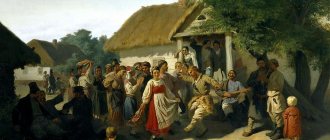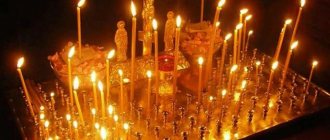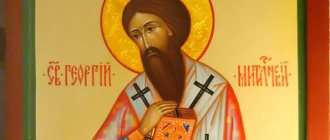Holiday calendar, signs, dates and events for every day of the year - folk calendar, Orthodox calendar, church calendar, eastern calendar, astrological calendar, lunar calendar, industrial calendar, state and professional holidays, including significant World and International holidays and public holidays, folk holidays and omens, and other equally interesting and unusual holidays, dates and events of the year, zodiac signs, dream books, and much more.
Calendar is a system for counting long periods of time, based on the periodicity of such natural phenomena as the change of day and night, the change of phases of the Moon , change of seasons.
Calendar - (from Latin Calendarium - debt book) a system for counting large periods of time, based on the visible movements of celestial bodies. The cyclic movement of such astronomical objects as the Earth, the Sun and the Moon is of primary importance for the construction and understanding of calendars. The word “calendar” itself comes from the Latin caleo (to proclaim), calendae (first day of the month) and, in fact, calendarium (debt book). A calendar is usually called a system of counting long periods of time based on the periodicity of natural phenomena, dividing them into shorter periods: millennia, centuries, years, months, weeks and days.
Calendar – (from Latin calendae or kalendae, “calends” - the name of the first day of the month among the ancient Romans), a way of dividing the year into convenient periodic time intervals. The main tasks of the calendar are: a) fixing dates and b) measuring time intervals.
The first calendar arose a long time ago, in ancient times, because there was a need to measure time. The word calendar comes from the Latin words caleo - to proclaim and calendarium - debt book. In Ancient Rome, debtors paid interest on the day of the calendar, the first days of the month) - a number system for large periods of time based on the periodicity of the movement of celestial bodies: the Sun - in solar calendars, the Moon - in lunar calendars, and at the same time both the Sun and Moon in lunisolar calendars .
The calendar allows you to record historical and social events in their chronological sequence. One of the important tasks of the calendar is to determine the moments of church events, moving and non-moving holidays (for example, Easter).
There are three main types of calendars: 1) lunar, 2) solar and 3) lunisolar.
1. Lunar calendar, which is based on a synodic lunar month with a duration of 29.5 average solar days. Originated over 30,000 years ago. The lunar year of the calendar contains 354 (355) days (11.25 days shorter than the solar one) and is divided into 12 months of 30 (odd) and 29 (even) days each (Muslim, Turkish, etc.). The lunar calendar is adopted as a religious and state calendar in the Muslim states of Afghanistan, Iraq, Iran, Pakistan, the United Arab Republic and others. Solar and lunisolar calendars are used in parallel for planning and regulating economic activities.
2. Solar calendar, which is based on the tropical year. Originated over 6000 years ago. Currently accepted as the world calendar. For example, the “old style” Julian solar calendar contains 365.25 days. Developed by the Alexandrian astronomer Sosigenes, introduced by Emperor Julius Caesar in Ancient Rome in 46 BC and then spread throughout the world. In Rus' it was adopted in 988 NE. In the Julian calendar, the length of the year is determined to be 365.25 days; three “simple” years have 365 days each, one leap year has 366 days. There are 12 months in a year of 30 and 31 days each (except February). The Julian year lags behind the tropical year by 11 minutes 13.9 seconds per year. The error per day accumulated over 128.2 years. Over 1500 years of its use, an error of 10 days has accumulated.
In the "new style" Gregorian solar calendar, the length of the year is 365.242500 days (26 seconds longer than the tropical year). In 1582, the Julian calendar, by order of Pope Gregory XIII, was reformed in accordance with the project of the Italian mathematician Luigi Lilio Garalli (1520-1576). The counting of days was moved forward by 10 days and it was agreed that every century that is not divisible by 4 without a remainder: 1700, 1800, 1900, 2100, etc. should not be considered a leap year. This corrects an error of 3 days every 400 years. An error of 1 day “accumulates” in 3323 years. New centuries and millennia begin on January 1 of the “first” year of a given century and millennium: thus, the 21st century and the 3rd millennium AD (AD) began on January 1, 2001 according to the Gregorian calendar.
In our country, before the revolution, the “old style” Julian calendar was used, the error of which by 1917 was 13 days. On February 14, 1918, the world-accepted “new style” Gregorian calendar was introduced in the country and all dates moved forward 13 days. The difference between the old and new styles was 11 days in the 18th century, 12 days in the 19th century, and 13 days in the 20th century - this will remain until 2100.
The solar calendar usually focuses on four main dates - two equinoxes and two solstices. The accuracy of a calendar is determined by how accurately the equinox falls on the same day each year. The lunisolar calendar is an attempt to harmonize the length of the lunar month and the solar (tropical) year through periodic adjustments. To ensure that the average number of days per year according to the lunar calendar corresponds to the solar year, a thirteenth lunar month is added every 2 or 3 years. This trick is required to ensure that the growing seasons fall on the same dates each year.
3. Lunisolar calendar, in which the movement of the Moon is coordinated with the annual movement of the Sun. The year consists of 12 lunar months of 29 and 30 days each, to which “leap” years containing an additional 13th month are periodically added to take into account the movement of the Sun. As a result, “simple” years last 353, 354, 355 days, and “leap” years last 383, 384 or 385 days. It arose at the beginning of the 1st millennium BC and was used in Ancient China, India, Babylon, Judea, Greece, and Rome. Currently adopted in Israel (the beginning of the year falls on different days between September 6 and October 5) and is used, along with the state one, in the countries of Southeast Asia (Vietnam, China, etc.).
Next: History of calendars...
Church calendar for every day
The church calendar is a time counting system used by the Orthodox Church to determine the sequence of church holidays and fasts in the annual cycle, as well as the corresponding services. Also the name of printed publications of various types, containing (in addition to general calendar functionality) elements of the monthly calendar and other materials of a liturgical and menological nature adapted to a specific year. The Church calendar contains two annual circles of events... Church calendar
Characteristics of people born on October 24
When a child is born, parents already imagine in advance how his future life will turn out. But their expectations are not always met. Many people are perplexed, what is the reason?
It turns out that good education and upbringing are important, but not the main components of personal development. A child may simply not live up to the expectations of his parents if they did not at one time take into account traits that are determined by the date of his birth. Therefore, it is so important to know in advance what basic qualities are already inherent in the child when he is born.
a person will behave in a particular area. This is determined by the innate characteristics of the future character. Knowing even a brief description of a person, you can adjust in advance the process of education and upbringing of a human individual:
- Character. A child born on this day will have a very scrupulous character. His desire for order in everything will sometimes reach the point of pedantry. However, his artistic inclination balances out this personality trait. Such people love to be the center of attention, but even a small problem or trouble can make them withdraw into themselves for a long time.
- Love. These people have a certain order in any manifestation of their feelings. Therefore, it is very easy to piss them off if this order is violated. They are very jealous. It is very important for these people to control their feelings, be it parental love or relationships with the opposite sex. The inability to keep abreast of all events can lead people born on October 24 to depression and stress.
- Career. Eternal careerists - this is how people born on this autumn day can be described. They will never be satisfied with their achievements. Their desire to climb the career ladder as high as possible is present throughout their lives. It doesn’t matter what position they hold. With a sufficient inclination towards artistry, such people become famous world-class artists.
- Health. Imbalance of the nervous system is one of the main problems of people born on October 24th. The inability to control their inner emotions often leads them to stress and depression.
Russian folk calendar for every day
Season: Winter - December, January, February.
Season: Spring - March, April, May.
Time of year: Summer - June, July, August.
Season: Autumn - September, October, November.
Venerable Theophan the Confessor, Creator of the Canons, Bishop of Nicaea
Veneration of Saint Theophan, the younger brother of Saint Theodore the Inscribed. He is the creator of about 150 canons. He became famous as a defender of icon veneration. He was exiled during the period of iconoclasm. Upon his return, he was ordained Bishop of Nicaea.
The Monk Theophan the Confessor was born in Constantinople into a pious and noble family. Theophanes' father was related to the Byzantine emperor Leo the Isaurian (717 - 741). Three years after Theophanes was born, his father died, leaving his family in the care of the emperor himself. Theophanes grew up at court and became a dignitary of Emperor Leo the Khazar (775 - 780). The situation obliged him to marry. By agreement with his bride, Theophanes remained chaste, for the desire to take on a monastic image was maturing in his soul.
Having once visited monasteries with his wife in the Sigrian region (Asia Minor), Theophanes met the perspicacious elder Gregory Stratigius, who predicted Theophanes' wife that her husband would be awarded the crown of martyrdom. After some time, Theophan’s wife was tonsured a nun in one of the monasteries of Bithynia, and Theophan took monastic vows from Elder Gregory. With the blessing of the elder, Theophanes built a monastery on the island of Kalonim in the Sea of Marmara and secluded himself in a cell, copying books. In this activity, Feofan achieved high skill.
Then the Monk Theophanes founded another monastery in the Sigrian region, in a place called “Great Village”, and became its abbot. The monk himself took part in all the monastic work and was an example of hard work and heroism for everyone. He was awarded by the Lord the gift of miracles: he healed diseases, cast out demons. In 787, the VII Ecumenical Council met in Nicaea, which condemned the heresy of iconoclasm. The Monk Theophan was also summoned to the Council. He arrived in patched rags, but shone with God-inspired wisdom in affirming the dogmas of true Orthodoxy.
At the age of 50, the Reverend fell seriously ill and suffered severely until his death. While on his deathbed, the monk worked incessantly: he wrote “Chronography” - the history of the Christian Church from 285 to 813. This work is still a valuable source on the history of the Church.
After the accession of Emperor Leo the Armenian (813 - 820), when the saint was already a very old man, iconoclasm resumed. Saint Theophan was forced to accept heresy, but he firmly opposed this and was imprisoned. His monastery “Velikoye Selo” was burned. After staying in prison for 23 days, the Reverend Confessor died (+ 818). After the death of the wicked emperor Leo the Armenian, the “Great Village” monastery was restored, and the holy relics of the confessor were transferred there.
2023:
— 1500 years
from the time of the departure to the Lord of
Arefa Negransky
, city ruler, martyr (+ 523).
- 1500 years
since the departure to the Lord
of the Negra
martyrs, numbering 4299, with unknown names (+ 523 year).
Troparion to the martyr Arefa and the many martyrs of Negran like him
, voice 1:
Having courage in Christ against the godless king, / the holy martyrs, / and having exposed the unbelief of the Jews in Christ, / accepted the torment of languor and beheading; / thus the Angels praised you, / and glorified your faithful relatives, Aretho, / and those who suffered with you, / / like those who continually pray for our souls.
Kontakion to the martyr Arefa and many like him to the Negran martyrs
, voice 4:
This is a joyful intercessor for us, today is a luminous feast of the passion-bearer, and by doing this, we glorify the existing Lord in the Highest.
— 1500 years
from the time of the departure to the Lord of
Synclitia Negrana
, the martyr (+ VI century) [+ 523]*.
- 1500 years
from the time of the departure to the Lord of
the Negran
martyrs, 2 in number, with unknown names, daughters of the martyr Synklitikia (+ VI century) [+ 523 year]*.
Troparion to the martyr Synklitikie and her two daughters Negransky
, voice 1:
The lambs of words, the Lamb and the Shepherd,/ brought by torment to Christ,/ having ended the course/ and having kept the faith,/ the same day we fulfill with a joyful soul,/ the venerable Syncletice and your holy daughters, your holy memory,/ magnifying Christ.
Kontakion to the martyr Synklitikie and her two daughters Negransky
, voice 2:
We celebrate the memory of the Passion-Bearers of Christ, / Synclitia and her two daughters, / and by faith asking for help / to deliver everyone from all sorrow, calling: / Our God is with us, / Who glorified these as he willed.
— 335 years
since the glorification
of the icon of the Mother of God “Joy of All Who Sorrow”
(1688).
Troparion of the Mother of God for the sake of Her Icon “Joy of All Who Sorrow”
, voice 4:
We are now diligent to the Mother of God, / sinners and humility, and let us fall, / in repentance calling from the depths of the soul: / Lady, help, having mercy on us, / struggling, we perish from many sins, / do not turn away your vain servants, / / You Imams have one hope.
Kontakion of the Mother of God for the sake of Her icon “Joy of All Who Sorrow”
, voice 6:
There are no imams of other help, / no imams of other hope, / unless You, Lady, / help us, / we rely on You, / and we boast in You: / For we are your servants, / / let us not be ashamed.
— 190 years
from the time of the departure to the Lord of
Zosima (
Verkhovsky )
, schemamonk, venerable (+ 1833).
Troparion to St. Zosima ( Verkhovsky
)
, voice 8:
A zealot of the Fatherland's teachings, / the all-red vegetation of the Siberian desert, / a vigorous ascetic of deeds and contemplation, a zealot of silence and the organizer of the monastery of the brides of Christ, / a vessel of the Spirit, Reverend Zosimo, // pray to Christ God that he may enlighten our souls.
Kontakion to St. Zosima ( Verkhovsky
)
, voice 4:
First of all, in the Siberian country/ you gave the nuns a deserted monastery,/ from there we are unjustly expelled,/ you placed your trust in the Providence of God,/ by which you are protected more than your mind,/ as if you were unharmed, making your journey,/ the Mother of God Hodegetria is controlled,/ Moscow You have reached the limits, / and here again we will take over the leadership of the monastery, / You have preserved your God-gathered flock for good, / You have left us your way of life / and your honey-bearing teaching, / Reverend Zosimo, / pray to Christ God / / to be preserved from all defilement of our souls.
— 105 years
from the time of the departure to the Lord of
Lavrenty (
Knyazev ) Balakhninsky
, bishop, martyr (+ 1918). — 105 years
since the departure to the Lord of
Alexy
Porfiryev , presbyter, archpriest, martyr (+ 1918).
- 105 years
since the departure to the Lord of
Alexy
Neidgardt , martyr (+ 1918).
Troparion to the Hieromartyrs Lavrentiy, Alexy and others like them, Martyr Alexy
, New Martyrs of the Russian Church, tone 4:
Today the Russian Church joyfully rejoices, / glorifying her new martyrs / Bishop-Priestmartyr Lawrence, / Presbyter-Priestmartyr Alexy, / and Holy Martyr Alexy, / in the days of the godless persecution, who laid down their lives for faith in Christ / and kept the Truth with their blood. / By those intercessions, Long-suffering Lord, preserve our country in Orthodoxy until the end of the age.
Kontakion to the Hieromartyrs Lawrence, Alexius and those like them to the Martyr Alexius
, New Martyrs of the Russian Church, tone 4:
Today the New Martyrs of Russia:/ Bishop-HolyMartyr Lawrence,/ Presbyter-HolyMartyr Alexis,/ and Holy Martyr Alexis,/ in white robes stand before the Lamb of God/ and with the Angels they sing a victorious song to God:/ blessing, and glory, and wisdom,/ and praise , and honor, and strength, and strength // to our God forever and ever. Amen.
— 85 years old
from the time of the departure to the Lord of
Peter
of Bogorodsky , presbyter, priest, martyr (+ 1938).
Troparion to Hieromartyr Peter of Bogorodsky
, New Martyr of the Russian Church, tone 3:
An unshakable pillar of the Russian Church, / the rule of piety, / the life of the Gospel, / Hieromartyr Peter, / who suffered for Christ’s sake even to the point of blood, / pray to Him earnestly, / as the Author and Finisher of salvation, / to establish Holy Rus' in Orthodoxy // until the end of the age.
Kontakion to Hieromartyr Peter of Bogorodsky
, New Martyr of the Russian Church, tone 2:
Let us praise, faithfully,/ Peter, distinguished as a priest/ and glorious among martyrs,/ a champion of Orthodoxy and a zealot of piety,/ the red vegetation of the Russian land,/ who through his suffering has reached Heaven/ and there warmly prays to Christ God/ to save our souls.
— 1720 years
from the time of the departure to the Lord of
Felix of Tibiuk
, bishop, martyr (+ 303).
- 1720 years
since the departure to the Lord of
Avdaktas of Carthage
, presbyter, martyr (+ 303 year).
- 1720 years
from the time of the departure to the Lord of
Ianuarius of Carthage
, presbyter, martyr (+ 303 year).
- 1720 years
since the departure to the Lord
of Fortunatus of Carthage
, reader, martyr (+ 303 year).
- 1720 years
since the departure to the Lord of
Septimus of Carthage
, reader, martyr (+ 303 year).
- 1720 years
from the time of the departure to the Lord of
Acacius of Armenia
, presbyter, martyr (+ 303 year).
(Back to top of page)
Historical origins of the holiday in honor of St. Philip
The birthplace of Saint Philip is the city of Caesarea in the Palestinian lands (now it is called Caesarea and is located in Israel). In his youth, as a devoted Christian, he was chosen to be a deacon, and he became one of the 70 apostles. This happened immediately after the death of Stephen, who died during persecution from the side of the pagans.
Having left his native land, Philip began to preach the word of Christ in the cities of Samaria. In addition to telling stories about the Lord, he was engaged in driving out unclean spirits and healing people from various diseases. In addition, the saint knew how to perform miracles, which attracted a large number of people to Christianity.
Historical facts indicate that Philip had 4 daughters who also believed in the Lord. They were prophetesses. One of them, named Hermione, had the ability to heal the sick. It is also known that Saint Philip died of natural causes while he was bishop of a city called Trallia.











